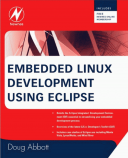Книга: Embedded Linux development using Eclipse
1.4.1 Workbench
1.4.1 Workbench
The workbench is the primary user interface for Eclipse. As such, it implements the Eclipse “personality” and supplies the structures that allow tools to interact with the user. Because of this central and defining role, the workbench is synonymous with the Eclipse Platform UI as a whole and with the main window you see when Eclipse is running.
The workbench, in turn, is implemented on top of two generic toolkits:
• Standard Widget Toolkit (SWT). A widget set and graphics library integrated with the native window system, but with an OS-independent API.
• JFace. A UI toolkit implemented using SWT that simplifies common UI programming tasks.
SWT provides a common API that works across a number of supported windowing systems. For each native windowing system, SWT translates its common API into native window widgets. Most common low-level widgets such as lists, text fields, and buttons are implemented natively. But some generally useful higher-level widgets, such as toolbars and trees, may need to be emulated on some window systems. The end result is that SWT maintains a consistent programming model in all environments, while preserving the look and feel of the underlying native window system. Thus, Eclipse on a Mac looks like a Mac OS application, Eclipse under Windows XP (or Vista if you prefer) looks like a Windows application, and so on.
JFace is a UI toolkit providing classes for handling many common UI programming tasks such as image and font registries, dialog, preference, and wizard frameworks, and progress reporting for long running operations. It sits on top of SWT and thus is independent of the native windowing system.
- 8.2.6. Учебный пример: инструментарий Documenter's Workbench
- 18.3.1. troff и инструментарий Documenter's Workbench
- 9.4 Wind River — Workbench
- Database Workbench
- Creating a Database in MySQL
- 18.3.4. POD
- 2.6. Транзакции и пути доступа меню
- CHAPTER 9 Eclipse-Based Development Products
- 2.4.6. Использование средств обслуживания таблиц
- 5.1. Инициализация системы изменений и переноса
- 6.7. Пути доступа транзакций и меню
- 8.2.2. Лицензионные данные




